About
- Branching and Merging
- Small and Fast
- Distributed
- Data Assurance
- Staging Area
- Free and Open Source
- Trademark
Branching and Merging
The Git feature that really makes it stand apart from nearly every other SCM out there is its branching model.
Git allows and encourages you to have multiple local branches that can be entirely independent of each other. The creation, merging, and deletion of those lines of development takes seconds.
This means that you can do things like:
- Frictionless Context Switching. Create a branch to try out an idea, commit a few times, switch back to where you branched from, apply a patch, switch back to where you are experimenting, and merge it in.
- Role-Based Codelines. Have a branch that always contains only what goes to production, another that you merge work into for testing, and several smaller ones for day to day work.
- Feature Based Workflow. Create new branches for each new feature you're working on so you can seamlessly switch back and forth between them, then delete each branch when that feature gets merged into your main line.
- Disposable Experimentation. Create a branch to experiment in, realize it's not going to work, and just delete it - abandoning the work—with nobody else ever seeing it (even if you've pushed other branches in the meantime).
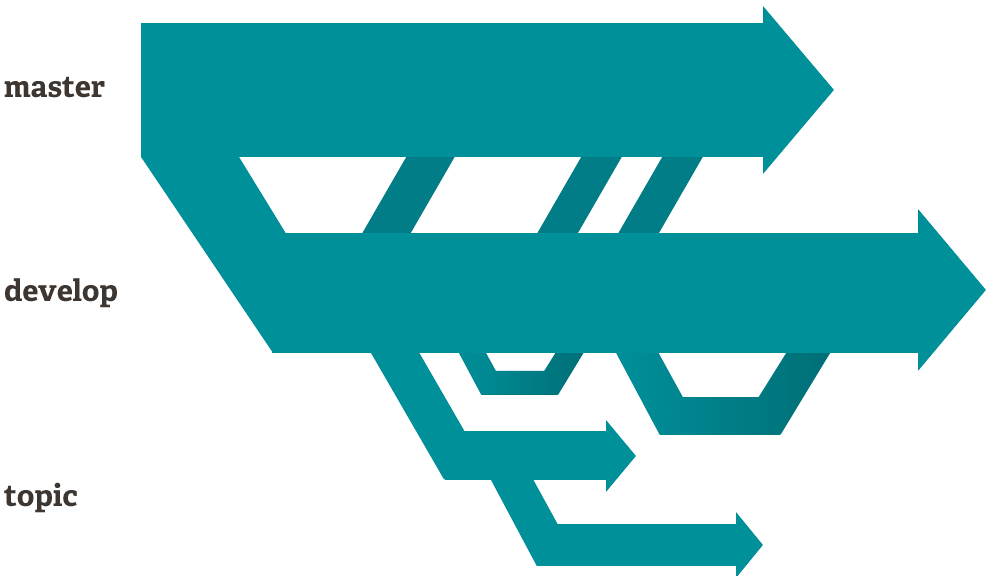
Notably, when you push to a remote repository, you do not have to push all of your branches. You can choose to share just one of your branches, a few of them, or all of them. This tends to free people to try new ideas without worrying about having to plan how and when they are going to merge it in or share it with others.
There are ways to accomplish some of this with other systems, but the work involved is much more difficult and error-prone. Git makes this process incredibly easy and it changes the way most developers work when they learn it.
Small and Fast
Git is fast. With Git, nearly all operations are performed locally, giving it a huge speed advantage on centralized systems that constantly have to communicate with a server somewhere.
Git was built to work on the Linux kernel, meaning that it has had to effectively handle large repositories from day one. Git is written in C, reducing the overhead of runtimes associated with higher-level languages. Speed and performance has been a primary design goal of Git from the start.
Benchmarks
Let's see how common operations stack up against Subversion, a common centralized version control system that is similar to CVS or Perforce. Smaller is faster.
|
|
|
|
|
|
|
|
|
|
|
|
|
|
For testing, large AWS instances were set up in the same availability zone. Git and SVN were installed on both machines, the Ruby repository was copied to both Git and SVN servers, and common operations were performed on both.
In some cases, the commands don't match up exactly. Here, matching on the lowest common denominator was attempted. For example, the 'commit' tests also include the time to push for Git, though most of the time you would not actually be pushing to the server immediately after a commit where the two commands cannot be separated in SVN.
All of these times are in seconds.
| Operation | Git | SVN | ||
|---|---|---|---|---|
| Commit Files (A) | Add, commit and push 113 modified files (2164+, 2259-) | 0.64 | 2.60 | 4x |
| Commit Images (B) | Add, commit and push a thousand 1 kB images | 1.53 | 24.70 | 16x |
| Diff Current | Diff 187 changed files (1664+, 4859-) against last commit | 0.25 | 1.09 | 4x |
| Diff Recent | Diff against 4 commits back (269 changed/3609+,6898-) | 0.25 | 3.99 | 16x |
| Diff Tags | Diff two tags against each other (v1.9.1.0/v1.9.3.0) | 1.17 | 83.57 | 71x |
| Log (50) | Log of the last 50 commits (19 kB of output) | 0.01 | 0.38 | 31x |
| Log (All) | Log of all commits (26,056 commits – 9.4 MB of output) | 0.52 | 169.20 | 325x |
| Log (File) | Log of the history of a single file (array.c – 483 revs) | 0.60 | 82.84 | 138x |
| Update | Pull of Commit A scenario (113 files changed, 2164+, 2259-) | 0.90 | 2.82 | 3x |
| Blame | Line annotation of a single file (array.c) | 1.91 | 3.04 | 1x |
Note that this is the best case scenario for SVN—a server with no load with a gigabit connection to the client machine. Nearly all of these times would be even worse for SVN if that connection was slower, while many of the Git times would not be affected.
Clearly, in many of these common version control operations, Git is one or two orders of magnitude faster than SVN, even under ideal conditions for SVN.
One place where Git is slower is in the initial clone operation. Here, Git is downloading the entire history rather than only the latest version. As seen in the above charts, it's not considerably slower for an operation that is only performed once.
| Operation | Git* | Git | SVN | |
|---|---|---|---|---|
| Clone | Clone and shallow clone(*) in Git vs checkout in SVN | 21.0 | 107.5 | 14.0 |
| Size (MB) | Size of total client side data and files after clone/checkout (in MB) | 181.0 | 132.0 |
It's also interesting to note that the size of the data on the client side is very similar even though Git also has every version of every file for the entire history of the project. This illustrates how efficient it is at compressing and storing data on the client side.
Distributed
One of the nicest features of any Distributed SCM, Git included, is that it's distributed. This means that instead of doing a "checkout" of the current tip of the source code, you do a "clone" of the entire repository.
Multiple Backups
This means that even if you're using a centralized workflow, every user essentially has a full backup of the main server. Each of these copies could be pushed up to replace the main server in the event of a crash or corruption. In effect, there is no single point of failure with Git unless there is only a single copy of the repository.
Any Workflow
Because of Git's distributed nature and superb branching system, an almost endless number of workflows can be implemented with relative ease.
Subversion-Style Workflow
A centralized workflow is very common, especially from people transitioning from a centralized system. Git will not allow you to push if someone has pushed since the last time you fetched, so a centralized model where all developers push to the same server works just fine.
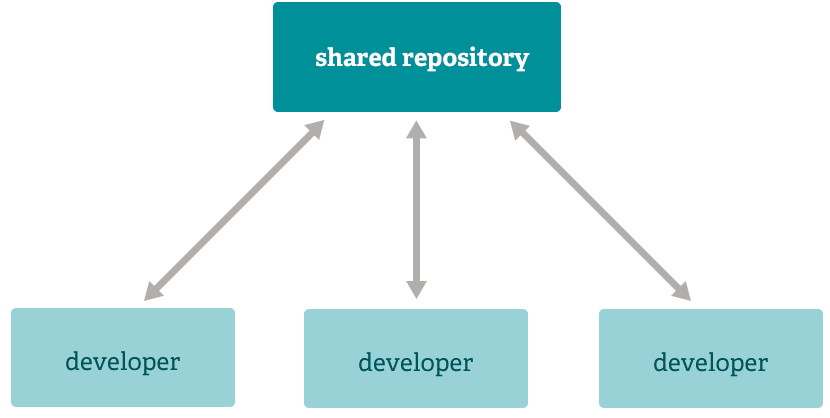
Integration Manager Workflow
Another common Git workflow involves an integration manager — a single person who commits to the 'blessed' repository. A number of developers then clone from that repository, push to their own independent repositories, and ask the integrator to pull in their changes. This is the type of development model often seen with open source or GitHub repositories.
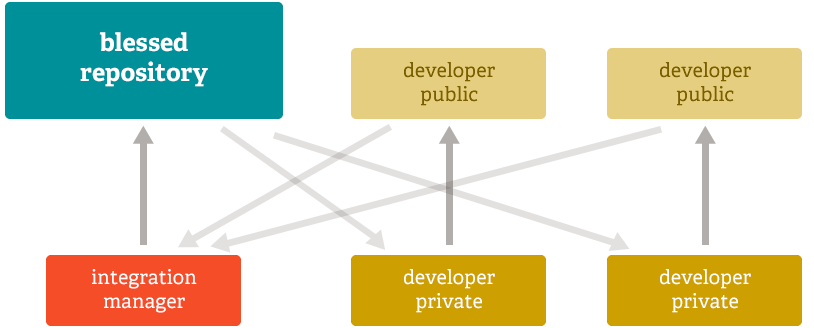
Dictator and Lieutenants Workflow
For more massive projects, a development workflow like that of the Linux kernel is often effective. In this model, some people ('lieutenants') are in charge of a specific subsystem of the project and they merge in all changes related to that subsystem. Another integrator (the 'dictator') can pull changes from only his/her lieutenants and then push to the 'blessed' repository that everyone then clones from again.
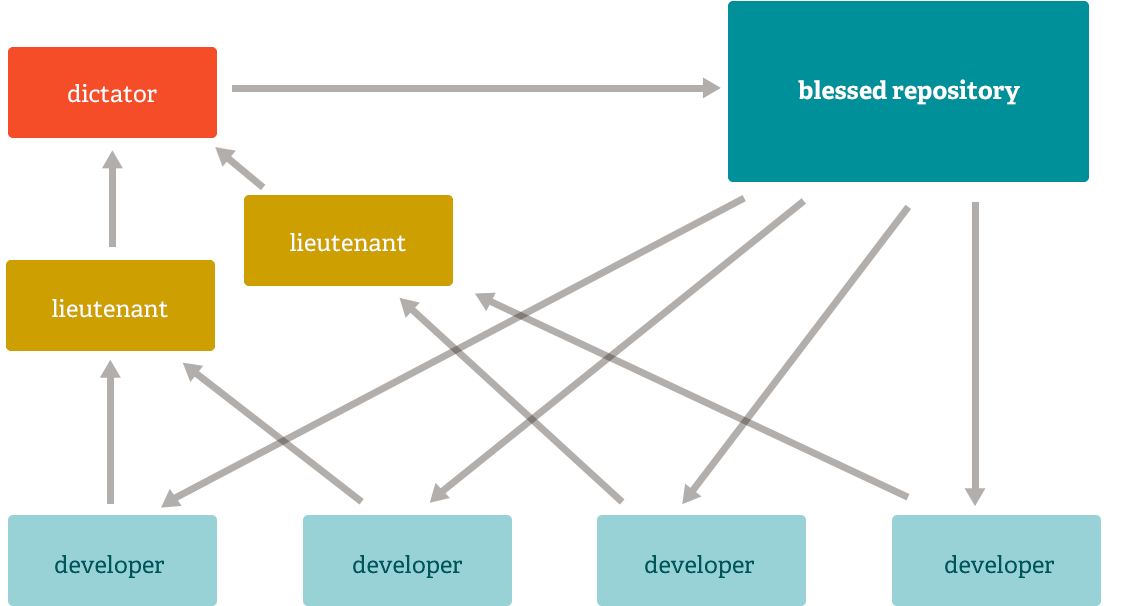
Data Assurance
The data model that Git uses ensures the cryptographic integrity of every bit of your project. Every file and commit is checksummed and retrieved by its checksum when checked back out. It's impossible to get anything out of Git other than the exact bits you put in.
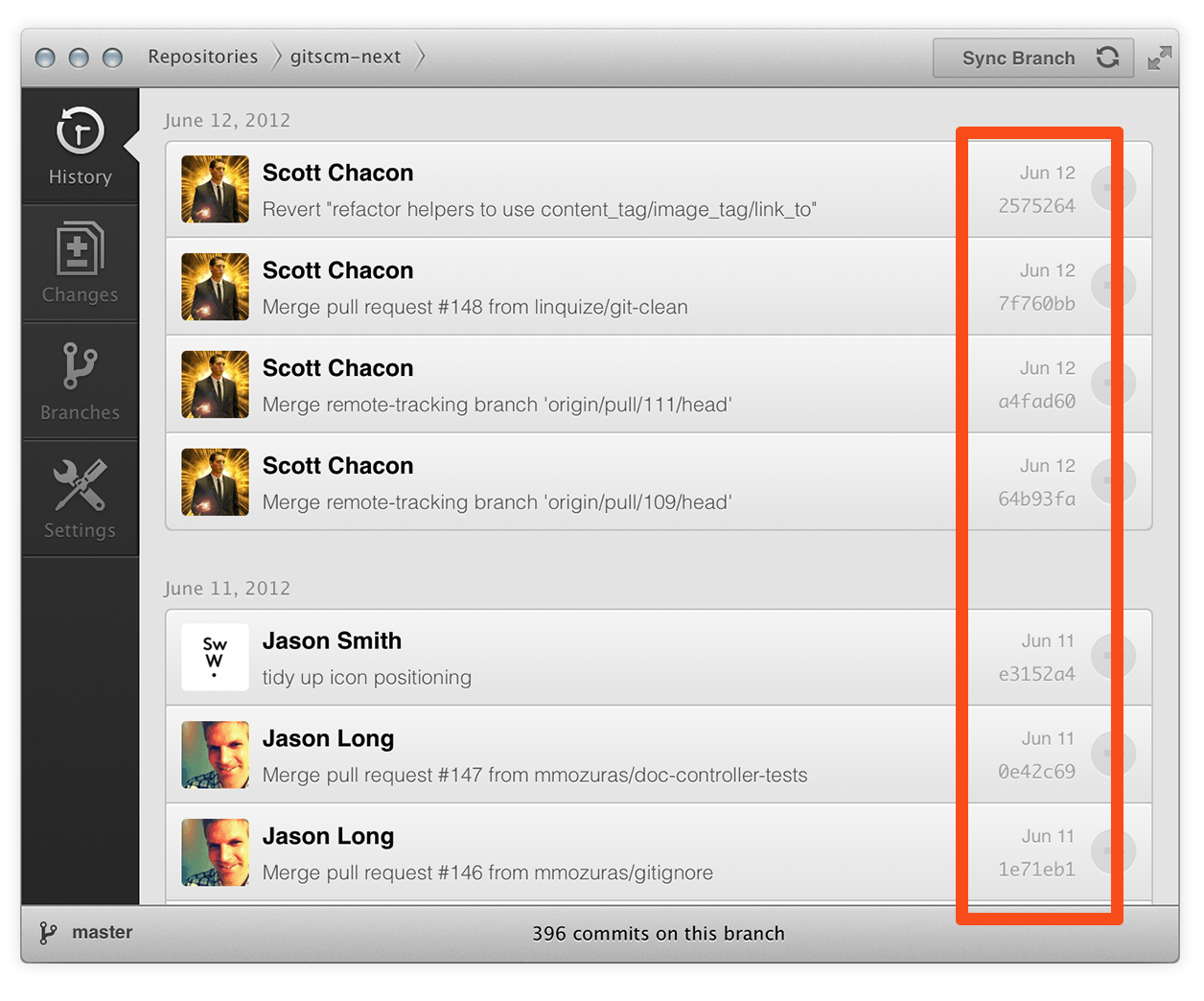
It is also impossible to change any file, date, commit message, or any other data in a Git repository without changing the IDs of everything after it. This means that if you have a commit ID, you can be assured not only that your project is exactly the same as when it was committed, but that nothing in its history was changed.
Most centralized version control systems provide no such integrity by default.
Staging Area
Unlike the other systems, Git has something called the "staging area" or "index". This is an intermediate area where commits can be formatted and reviewed before completing the commit.
One thing that sets Git apart from other tools is that it's possible to quickly stage some of your files and commit them without committing all of the other modified files in your working directory or having to list them on the command line during the commit.
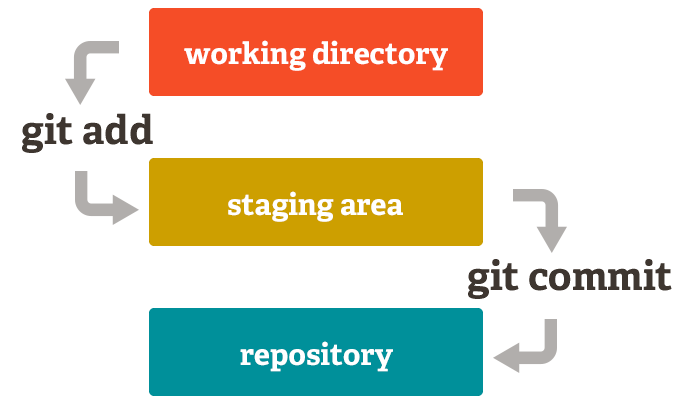
This allows you to stage only portions of a modified file. Gone are the days of making two logically unrelated modifications to a file before you realized that you forgot to commit one of them. Now you can just stage the change you need for the current commit and stage the other change for the next commit. This feature scales up to as many different changes to your file as needed.
Of course, Git also makes it easy to ignore this feature if you don't want that kind of control — just add a '-a' to your commit command in order to add all changes to all files to the staging area.
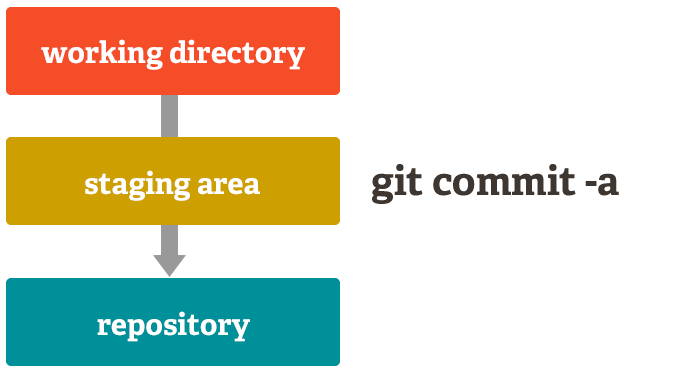
Free and Open Source
Git is released under the GNU General Public License version 2.0, which is an open source license. The Git project chose to use GPLv2 to guarantee your freedom to share and change free software---to make sure the software is free for all its users.
However, we do restrict the use of the term "Git" and the logos to avoid confusion. Please see our trademark policy for details.
GIT TRADEMARK POLICY
1 Purpose
The Git Project is a member project of Software Freedom Conservancy ("Conservancy"). Conservancy holds rights in the Marks on behalf of the Git Project in accordance with its non- profit charitable mission.
Conservancy has adopted this Policy to protect the Marks (as defined below) and to make sure that the identity of Git software and its free and open source nature is clear to everyone. By using this Policy, the Git Project can spread the use of the Git software while making sure that the Marks are protected in a way that's consistent with U.S. trademark law (U.S. Registration 4680534). This Policy is written to allow all clear and appropriate use of the Marks while disapproving use of the Marks in ways that could confuse users as to where the software came from, or that implies an otherwise non- existent association with the Git Project. By adhering to this Policy, you help to promote to the public the freedom to use and develop the Git software.
Throughout this Policy, the word "Marks" refers to the following:
the literal mark "Git"
The logos and graphic marks displayed and available for download at https://git-scm.com/downloads/logos
The slogan "the stupid content tracker"
This Policy is only concerned with the Marks associated with the Git Project, and does not address any copyrights associated with the Git software.
2 Guidelines for using the Marks
2.1 Trademark symbol on first mention
The first prominent mention of a Mark should be immediately followed by a symbol for, as applicable, a registered trademark (®) or an unregistered trademark (™). For example: "Git™".
This requirement is waived in all contexts where such marks are not required to protect the intellectual property rights associated with the Marks, such as email, online discussion, and academic papers. We encourage the use of the applicable symbols whenever possible, but recognize that many users will omit them in non-commercial and informal contexts.
You can use "Git and the Git logo are either registered trademarks or trademarks of Software Freedom Conservancy, Inc., corporate home of the Git Project, in the United States and/or other countries." when you need to mention "Git" in e.g. list of trademarks held by other people.
2.2 Use of the Marks without written permission
You may use the Marks without prior written permission (subject to the other sections):
To refer to the Git software in substantially unmodified form. "Substantially unmodified" means built from the source code provided by the Git Project, possibly with minor modifications including but not limited to: the enabling or disabling of certain features by default, translations into other languages, changes required for compatibility with a particular operating system distribution, or the inclusion of bug-fix patches.
To identify the Git software as a distinct component of a software offering.
To factually refer to the Git Project itself, its products, or its protocols.
In addition, you may use the Marks to refer to products, services, or communities outside of the Git software and Git Project without written permission in the following contexts:
- When referring to Git software that is not substantially unmodified, to say that such software is a "derivative of" or "based on" Git.
- When referring to a third-party software product and/or service that is interoperable with the Git software, in the format "[Product Name] for Git" -- provided that such use otherwise complies with the rest of this Policy.
We do not charge a fee for a license to use the Marks in these contexts. However, we do of course welcome donations. If you're interested in donating to the Git Project, care of Conservancy, visit https://git-scm.com/sfc. Conservancy is a United States 501(c)(3) public charity.
2.3 Prohibited usages of the Marks
You may not use the Marks in the following ways:
In any way likely to cause confusion as to the identity of the Git Project, the provenance of its software, or the software's license.
In any way that indicates a greater degree of association between you and the Git Project than actually exists.
In any way that implies a designated successor to Git (e.g., "Git++" is not permitted).
In any way that indicates that Git favors one distribution, platform, product, etc. over another except where explicitly indicated in writing by Conservancy.
In any other way that dilutes or otherwise infringes upon the trademark rights of Conservancy and the Git Project in the Marks.
To refer to the Git software, modified by a third party to the point of inoperability with Git software in substantially unmodified form.
In addition, you may not use any of the Marks as a syllable in a new word or as part of a portmanteau (e.g., "Gitalicious", "Gitpedia") used as a mark for a third-party product or service without Conservancy's written permission. For the avoidance of doubt, this provision applies even to third-party marks that use the Marks as a syllable or as part of a portmanteau to refer to a product or service's use of Git code.
2.4 Limitations to this Policy
This Policy does not confer any rights to use the trademarks "Software Freedom Conservancy," "Conservancy," or to use any other trademarks other than the Marks listed in Section 1. This Policy does not authorize you to act as an agent for Conservancy, enter into any agreement on behalf of or otherwise create any liability for the Git Project or Conservancy.
2.5 Use of the Marks in merchandising
You may not create and/or sell merchandise bearing any of the Marks without Conservancy's express written permission. If you are interested in using creating and/or selling merchandise bearing any of the the Marks, please send proofs of your designs to us at TRADEMARK@SFCONSERVANCY.ORG.
3 Rights reserved by Conservancy
Conservancy reserves the sole right to:
Determine compliance with this Policy.
Modify this Policy in ways consistent with its mission of protecting the public.
Grant exceptions to this Policy, of any kind and for any reason whatsoever, other clauses notwithstanding.
4 Questions
This Policy is designed to keep the Marks safe in order to protect this software's reputation, earned by the contributions of the Git Project to the free and open source software community and to the public at large. If you see any use of the Marks anywhere that you think violates this Policy or otherwise goes against the spirit of the Git Project and Conservancy's mission, please bring it to Conservancy's attention by contacting us at TRADEMARK@SFCONSERVANCY.ORG.
If you have questions about using the Marks, or if you think you should be able to use the Marks for any purpose not allowed by this Policy and would like permission for that use, please contact Conservancy by emailing TRADEMARK@SFCONSERVANCY.ORG or by writing to Git Project c/o Software Freedom Conservancy, 137 Montague St. Ste 380, Brooklyn, NY 11201-3548.